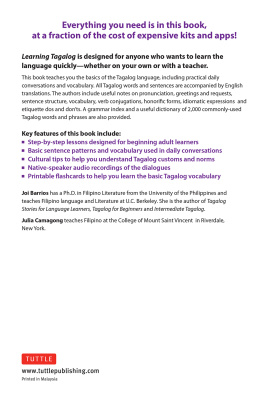Acknowledgments
The author would like to thank the following for their help:
Consultant | : | Romulo Baquiran Jr. |
Book Lead Assistants | : | Jan Tristan Gaspi |
Althea Contreras |
Research Assistants | : | Paulene Rejano |
Abigail Ong |
Raphael Bernabe |
Nilalaman Table of Contents
The Tuttle Story: Books to Span the East and West
Many people are surprised to learn that the worlds leading publisher of books on Asia had humble beginnings in the tiny American state of Vermont. The companys founder, Charles E. Tuttle, belonged to a New England family steeped in publishing.
Immediately after WW II, Tuttle served in Tokyo under General Douglas MacArthur and was tasked with reviving the Japanese publishing industry. He later founded the Charles E. Tuttle Publishing Company, which thrives today as one of the worlds leading independent publishers.
Though a westerner, Tuttle was hugely instrumental in bringing a knowledge of Japan and Asia to a world hungry for information about the East. By the time of his death in 1993, Tuttle had published over 6,000 books on Asian culture, history and arta legacy honored by the Japanese emperor with the Order of the Sacred Treasure, the highest tribute Japan can bestow upon a non-Japanese.
With a backlist of 1,500 titles, Tuttle Publishing is more active today than at any time in its pastinspired by Charles Tuttles core mission to publish fine books to span the East and West and provide a greater understanding of each.
Published by Tuttle Publishing, an imprint of Periplus Editions (HK) Ltd.
www.tuttlepublishing.com
Copyright 2015 by Joi Barrios
All rights reserved. No part of this publication may be reproduced or utilized in any form or by any means, electronic or mechanical, including photocopying, recording, or by any information storage and retrieval system, without prior written permission from the publisher.
Cover photo Christopher Futcher | Dreamstime.com
LCC Card No. 2014957346
ISBN 978-0-8048-4262-4
ISBN 978-1-4629-1427-2 (ebook)
First edition
20 19 18 17 16 15 6 5 4 3 2 1 1501CM
Printed in China
Distributed by
North America, Latin America & Europe
Tuttle Publishing
364 Innovation Drive
North Clarendon,
VT 05759-9436 U.S.A
Tel: 1 (802) 773 8930 | Fax: 1 (802) 773 6993
www.tuttlepublishing.com
Japan
Tuttle Publishing
Yaekari Building, 3F
5-4-12 Osaki, Shinagawa-ku
Tokyo 141-0032
Tel: (81) 3 5437-0171 | Fax: (81) 3 5437-0755
www.tuttle.co.jp
Asia-Pacific
Berkeley Books Pte Ltd
61 Tai Seng Avenue #02-12
Singapore 534167
Tel: (65) 6280-3320 | Fax: (65) 6280-6290
www.periplus.com
TUTTLE PUBLISHING is a registered trademark of Tuttle Publishing, a division of Periplus Editions (HK) Ltd.

Dedication
To my cousin and childhood friend, Deona Enriquez; my husband, Pierre Leblanc; and our son Eli.
A Note to the Learner
The following are printable PDF documents on the disc:
Mga Talang Pangkultura Culture Notes (Lessons )
Pakikinig Listening (Lessons )
Grammar Index
Abilitative affixes:
ma- -an , Lesson 9
na- , nakapag- , Lessons 2, 3, 7, 9
naka- , Lesson 18
nakapang- , Lesson 9
napaka- , pinaka- , magkasing- , Lesson 3
Adverbs of Frequency
palagi (always), madalas (often), minsan , paminsan-minsan (sometimes), bihira (rarely), and hindi kailanman (never), Lesson 5
Affixes
-an , Lessons 3, 9
in- , Lessons 3, 9
in- -an , Lesson 3
in- vs. na- reflecting intent, Lesson 13
ka- + duplication of root word, Lesson 9
ka- / magka- / magkaka- , pinaka- , Lesson 9
ma- , Lessons 6, 9
ma- -in , Lesson 9
mag- , Lesson 3
mala- , mapag , mapang- , maka- , pala- , Lesson 9
naka- participle and/or affix to form adjectives, verbs and nouns, Lesson 13
napa- , Lesson 9
pa- (indication of something someone is going to do), Lesson 14
um- , Lessons 2, 3, 9, 16
Affixes used for adjectives and verbs: mag- -an , na- + , na- -an , naka- , nakapag- , and napa- , Lesson 9
Affixes used in causative sentences:
i- -pa- , Lessons 4, 18
-in , Lesson 4
ipinag- , pina- -an , Lesson 6
i + pa + pang , Lessons 4, 18
ipina-/pina- , nagpa- , Lessons 16, 17, 18
mag-pa , Lessons 4, 18
na- -an , Lesson 19
na- + i , Lesson 17
pa- -an , Lesson 16
nagpa- , pina- and pina-an , Lesson 8
pa- , Lesson 16
pa- -in , Lessons 4, 16, 18
pa- -in- -an , Lesson 4
Affixes which mean used for: pang- , pam- , pan- , pang-an , Lessons 3, 9
ang , Lessons 5, 13
ayaw and yata , Lesson 14
Clauses presenting reason: dahil/dahil sa , dahilan sa , gawa ng , sapagkat/ pagkat , and porke , Lesson 20
Clauses expressing purpose: upang , para , Lesson 20
Clauses expressing results: yayaman din lamang , kaya , Lesson 20
Expressions of time:
umaga (morning), hapon (afternoon), gabi (evening), linggo (week), and buwan (month), Lesson 14
hindi (no)/ wala (not have), Lesson 1
kasing / magkasing usage Lesson 9
ko / ako pronouns, Lesson 5
mas , Lesson 3
may / mayroon / meron (have), Lesson 1
na (perfect and present perfect continuous tense, use of na ), Lessons 5, 7
na (contracted as -ng and -g ) as a relative pronoun, Lesson 14
naging (became), magkaroon (will get, develop, acquire), nagkaroon (got; developed; acquired), maging , Lessons 1, 8
nang , Lessons 1, 5, 11
ng , Lessons 1, 13
Noun affixes
-an/-han , mag- , mang- , sang- , sam- , or san- , pag- , pag- -an , pag- -in- -an , tag- , taga- , tala- , Lesson 12
Plural action words affixes: magsi- (plural affix for um- verbs), magsipag- (plural affix for mag- verbs), pag- -in (plural form for in- verbs), and pag- -an (plural affix for -an verbs), Lesson 15
Plurality: ano-ano , sinosino , saan-saan , Lessons 6, 15
Reciprocal verbs affixes: nag- -an , Lesson 12
Reported Speech, daw or raw , Lesson 13
sa , Lesson 13
Social affixes: naki- , and pinaki- , Lesson 14
Tag questions, ba , Lesson 13
Verb affixes to show social action: nagsi- , nangagsi- , nagsipag- -an , Lesson 6
Glossary
A
abenida avenue
aklatan library
aba exclamation of surprise or wonder; so!
abay wedding sponsor
abiso notice
abot-tenga ang ngiti smiling from ear to ear
abuhin salt and pepper [refers to hair]
agila eagle
aksiyon action
alagad ng batas literally, officers of law; refers to police officers
alak wine
alalahanin remember
ale/aleng used to address an older woman
alikabok dust
alimango crab
alipin slave
alon wave
alon-alon wavy
alta presyon high blood pressure
ama father
ama-amahan one who acts like a father to you
amain stepfather
ambag contribute
amihan northeast wind
anak child
anak na babae daughter (literally, child that is a woman/girl)
anak na lalaki son (literally, child that is a boy/man)
Ang ganda ganda! So beautiful!
ang mabuti ho siguro perhaps it would be good if
ang nakapatay the person who killed [the victim]
Ang saya saya! So happy!
anghitin stinky
anino shadow
anino ng pagkalunos literally, shadow of despair; desperation
Next page













